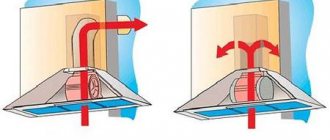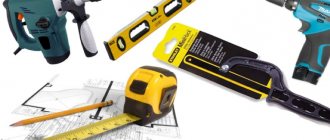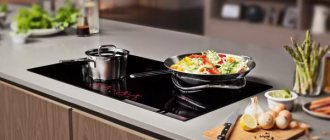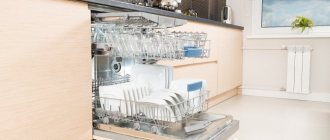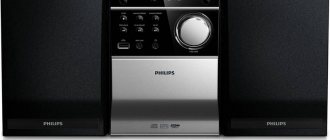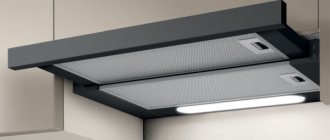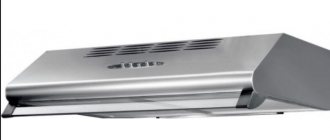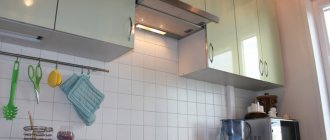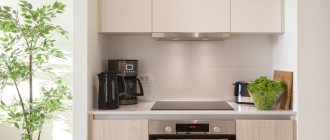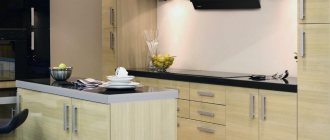To choose the right ventilation device, it is not enough to buy a high-quality and reliable hood. It is important that it has the required power. If it does not meet the necessary requirements, it will not be able to provide clean air in the room. During operation, a kitchen hood can only pass a certain volume of air through itself. It is necessary to calculate in advance what power it should have.
Recommended power
The operation of the ventilation system is characterized by how many cubic meters of air enter the room through it. To accurately find out this value, you need to calculate the power of the kitchen hood. If the power of the hoods is insufficient, the hood will not work properly. Correct calculation helps to avoid the following:
- The appearance of thermal fumes from heating devices. These could be combustion products, moisture, overheated air. A well-functioning hood will keep the air in the room clean and cool.
- Odors that arise during the cooking process. If you do not remove them, they will not only spread throughout the apartment, but will also be able to survive for a long time.
- If the housewife's food is burnt, this will create rare unpleasant odors. If they persist until the moment of eating, they will not contribute to the appearance of appetite.
- The constant presence of gas combustion and cooking products in the air increases the likelihood of respiratory tract diseases.
- The presence of very humid and highly overheated air, which has a destructive effect on the walls, is eliminated. Ceiling and furnishings.
- High humidity creates a favorable environment for mold to form. If it occurs, you will have to spend significant effort to get rid of it.
- Odors that are not removed by the hood can create stains on the walls and ceiling. In this case, they will have to be cleaned, which can be a labor-intensive procedure.
Some do without additional ventilation devices. This is only possible in cases where air pollution is insignificant. You can more accurately determine whether a kitchen hood is needed based on the following signs:
- You need to check if the built-in hood works. This can be determined by the presence of traction. To do this, just bring a burning match to the hole. If it deviates, then we can conclude that thrust exists.
- To check, you can use a sheet of A4 paper. If you lean it against the exhaust hole and release it, it should lock into place if there is traction. If it falls, it means that the kitchen hood is not working or is working very weakly. In this case, you will need to calculate the kitchen hood to get a more accurate value.
In cases where it is obvious that ventilation does not clean the air, you need to think about installing a hood. Before choosing a model, you need to calculate what the required power of the equipment will be.
It is important to calculate in advance how much air supply should be provided. The purchase must be made on the condition that the exhaust power is sufficient to ensure the required quality of work. To do this, you need to make a ventilation calculation.
In most cases, such devices provide a supply of 200-300 cubic meters. m. per hour. In most cases, this power is not enough for a kitchen hood. If you do not make the necessary calculations and buy standard equipment, it may turn out that the kitchen will not be ventilated to the required extent.
In most cases, the minimum requirements even for conventional kitchens exceed the capacity of a kitchen hood of 500 cubic meters. m. per hour. Devices that are too low-power can only be suitable in certain cases, when the area of the room is small, and cooking is rarely done here. The cost of such devices is relatively low, but the quality of work is only suitable in rare cases. Installing such a hood in the kitchen may not be enough.
If you work a lot in the kitchen and cook regularly, then in most cases a 600 cubic meter unit may be suitable. m. per hour. You can verify this by doing your own air exchange calculations. Sometimes it will be better if you buy a unit that provides a capacity of 1000 cubic meters. m. per hour. Such hoods are more expensive, but can provide high-quality indoor air. Before choosing equipment, you need to clarify the required parameters.
Types of kitchen hoods
The hood must be selected according to its power so that odors do not spread to other rooms.
The domestic market offers a wide range of ventilation products of various classes. It takes into account the characteristics of the kitchen space and the design of the exhaust unit itself. Among the presented samples, the following designs are distinguished based on these characteristics:
- dome model;
- hidden in pieces of furniture;
- telescopic;
- flat.
- T-shaped (island) or box-shaped.
The first type of exhaust structure is mounted directly above the stove, forming something like a dome that draws in air. It has significant dimensions and has an attractive appearance, reminiscent of an expensive fireplace. The hidden version of hoods refers to practical models that are built directly into kitchen furniture. Its owner can only see a small part of the product with the control panel placed outside.
The interior space of the cabinet in which such a device is mounted may be used for other purposes. This type of kitchen ventilation is available in relatively inexpensive models, suitable for users who want to save on the space occupied by equipment. Telescopic hoods are also mounted discreetly; To bring them into working position, it is enough to pull out the panel with the grease filters built into it.
Flat structures operate in the mode of natural circulation of air masses through the air ducts connected to them and are among the simplest devices of this class. Installation of such systems, as a rule, does not cause difficulties, since they do not need to be connected to an existing ventilation system. They are suspended directly above the stove parallel to the wall.
Island or T-shaped appliances are intended for large kitchen spaces or in the presence of ventilation systems combined with a bathroom. They are mounted on the walls or ceiling directly above the work plate and are characterized by a fairly high power rating. This category also includes box-shaped models that look like a pipe or steel box and are good at eliminating odors in the kitchen and bathroom.
Power calculation
To correctly select the unit, it is necessary to calculate the necessary power requirements in advance. To determine this parameter, one must proceed from existing sanitary requirements. In accordance with them, within every hour the entire volume of air in the room must completely change 12 times. Before determining the power of a kitchen hood, you need to take into account the factors that influence it.
Calculation of the air exchange of the unit can be done as follows, using the following formula:
Q = S x H x 12
It uses the following notations:
- Q is the power that the hood should have;
- S represents the area of the room, measured in square meters. m.;
- Y is its height.
Factors affecting power calculation
To calculate the performance of a kitchen hood, the formula is used:
Q=s × h × 12.
Here, only the size of the room, height to the ceiling and air exchange rate are taken into account. This is a correct calculation, but not complete.
In addition to the kitchen area, the following parameters must be taken into account:
- family composition (clean air consumption must meet sanitary standards per person);
- frequency of cooking;
- what dishes are prepared (with fatty broth or healthy food);
- cross-section, length, material of air ducts.
Slab type
Undoubtedly, the area and type of stove affects the performance of the hood. The type of stove affects the amount of waste in the form of scale and burning that gets into the air when frying meat, boiling borscht, or healthy food with only vegetables. At the same time, the flow of fresh air into the room also occurs in different ways. Consequently, the air exchange rate also changes.
Let's take a closer look at how this happens:
- The calculation of a kitchen hood in the presence of an electric stove differs from the classic one, since combustion products do not penetrate into the air, except for steam from cooking food. As a rule, the air exchange rate for these electric stoves is increased in calculations from 12 to 15, while the classic formula will also change as follows:
Q=S × H × 15.
- When a gas stove is used, the air exchange rate increases to 20. This is due to the fact that in addition to evaporation, combustion products in the form of burning, soot, scorch, etc. enter the air space above the stove. Here the formula for calculating productivity will be different: S × H × 20.
- It would be incorrect to state unequivocally that if there is a cooking surface with an area of 65 cm, the hood should be more productive than with a smaller stove of 55 cm. However, logically this can be assumed, because larger hoods process the air mass from a stove of a larger surface. It is simply impossible to completely remove all harmful particles and odors from cooking at low power.
It is important not to make mistakes when calculating device parameters. Calculating the power of a hood is much easier if you take into account the main aspects.
Kitchen location
When calculating the performance of a kitchen hood, the type, area and isolation of it are taken into account. This could be: an apartment in the form of a studio, a kitchen and living room at the same time, a separate kitchen. Also, sometimes an arch is installed in the opening instead of a door, or the door is constantly open, in which case these parameters must also be taken into account.
Here the kitchen, one way or another, is combined with the adjacent room, so the conditions for calculating the performance of the hood increase several times. Thus, when calculating the power of the device, you need to take into account these additional parameters in the adjacent room, thereby fully providing your household with fresh air.
There is an opinion among users that in a small kitchen a low-power hood is sufficient. But in a small room, odors dissipate faster, which means there is a greater amount of polluted air.
Accordingly, in order for the air to be clean, air exchange must occur more often. However, a low-power hood simply will not be able to provide this, or the engine will overheat and sooner or later burn out.
Hob type
Calculating the power of a kitchen hood should take into account not only existing standards, but also how food is prepared. The order in which the kitchen operates depends on the composition of the family and the intensity of use of the stove. For example, if one person lives in an apartment and only occasionally looks into the kitchen, then the need for air purification will be lower than in a large family where the stove is on almost constantly.
When calculating the power of a kitchen hood, an important consideration is the type of hob used. For example, when using an electric stove, only those fumes that are associated with cooking occur. If we are talking about a gas stove, then gas combustion products are added to them.
To take this circumstance into account, you need to know how to correctly calculate the required value. This difference is taken into account by adjusting the numerical coefficient in the power calculation formula. For normal conditions it is equal to 12, but to take into account the types of hob used it can be adjusted as necessary. Its value is defined as follows:
- If the housewife cooks on an electric stove, then a value of 15 is used.
- When working on a gas stove, it is set to 20 due to the formation of a large volume of air that needs to be purified.
If air is transferred into a ventilation shaft, its capacity must be taken into account. It is preferable that it corresponds to the volume of pumped air.
Although calculating the performance of a kitchen hood usually does not take into account the dependence on the size of the stove, it nevertheless needs to be taken into account. A larger cooking surface produces more heat and requires higher operating power.
Nuances of calculating kitchen hoods
The above formula is basic and does not reflect some of the features of a particular kitchen.
The amount of harmful emissions depends not only on the method of cooking (frying, boiling), but also on the type of cooking surface. Consequently, the frequency of air exchange will be different. If, for example, for a kitchen with an electric stove, taking into account force majeure, a 15-fold air exchange will be sufficient, then a 20-fold air exchange is necessary for a gas stove (after all, gas combustion products are added to the fumes from cooking).
The hood above the gas stove should be more powerful
We recommend reading: The principle of operation of a gas heating boiler, types, efficiency, device, diagram
The calculated performance assumes constant operation of the hood at maximum speed. This means that you will be accompanied by constant noise from the fan while cooking. Agree that this is quite tedious. Therefore, it is wiser to purchase a hood with a good safety factor. For a standard kitchen of 12 square meters. m and a height of 2.5 meters, a device with a capacity of:
— 486 m3/h – with electric stove;
— 648 m3/h – with a gas stove.
Based on the above information, the conclusion suggests itself: the basic calculation formula will give you an idea of the minimum permissible hood performance for your kitchen. If you like a device whose power is less than the calculated one, don’t take it: it will be just a useless trinket, and not a working unit.
- Many sellers, with the confidence of experienced specialists, advise owners of small kitchens to purchase the most primitive hoods with low performance. This is a misconception: in a small room the concentration of harmful fumes is much higher than in a spacious kitchen, therefore the device must have good performance.
- The exhaust system is not a complete replacement for the ventilation system. Its purpose is to remove contaminated air in the hob area.
- No matter how high-performance the hood is, its power drops in an unequal struggle with the throughput of the ventilation duct to which the air duct is connected. In our apartments, the ventilation duct can pass no more than 180 m3/h. Its cross-sectional size is only 130x130 mm. You can buy a powerful hood with 1.5 thousand cubic meters, but its effect will depend on the cross-section of the channel. Anything he doesn't miss can be considered a loss. Therefore, the best solution is to buy a recirculating hood.
Types of hoods for the kitchen
Hood type
When choosing a hood, you need to understand how it differs from ventilation. According to regulatory requirements, every living space must be provided with fresh air.
This is achieved by equipping air inlets and outlets. They ensure that contaminated air exits through the exhaust pipe and fresh air enters. Ventilation is provided by natural air movement.
In most cases, its use is sufficient, but in this way it is impossible to remove steam, soot, and odors that form in the kitchen. An exhaust hood is used here to purify the air. It, unlike conventional ventilation, performs forced air purification. The hood collects all the polluted air and helps remove it outside. Before you calculate a kitchen hood, you need to decide on the type of device used.
Air purification using exhaust ventilation can be done in various ways. Some types of devices simply remove air to the outside. They are called flow-through. Others, recirculating ones, clean it and return it back.
There are combined types of devices that simultaneously use both methods of operation. Calculation of the hood's performance based on the kitchen area is carried out in accordance with sanitary standards.
Flow devices involve the use of large cross-section pipes. They can be round or square, or have a corrugated surface. Grease filters are located in the lower inlet part. They are designed to absorb grease and other airborne contaminants.
There are fans inside the structure that provide air movement. From the hood, air enters the ventilation system and is then discharged outside.
The recirculation hood is not connected to the ventilation system. The air inside it moves in a closed loop. This unit uses virtually no pipes. The fan extracts air and passes it through a special cleaning filter.
Such systems do not have bulky parts and look more aesthetically pleasing compared to flow-through devices. Filters used for coarse cleaning are made of aluminum. They can be cleaned using detergents.
Electrical energy is required to operate the hood, since air movement is ensured by constantly switched on fans. Usually they can operate in several modes. When turned on, it selects the one that best matches the intensity of work in the kitchen.
What types of kitchen hoods are there?
Before proceeding to calculate the required power of the hood, you should decide on its type. There are several varieties of these household appliances. The difference between them is not only in design, but also in the principle of operation. This can be either the removal of polluted air from the room or its recirculation after appropriate cleaning.
Dome
The polluted air, after entering the dome of such an exhaust hood, is thrown out by fans outside through a piping system.
Features of dome-type exhaust devices:
- The system requires a minimum of maintenance, but during its operation it requires an influx of fresh air into the room from outside.
- If the kitchen has modern double-glazed windows that do not allow air to pass through, then you may need to open the window while the hood is operating.
- The disadvantages of this system also include quite significant dimensions and complex installation.
- Such hoods are recommended for use in spacious rooms.
- The complex of boxes and corrugated connections must have a minimum of bends that impede the movement of air.
Flat
These hoods are more compact and easy to install. Unlike dome ones, they do not require connection to ventilation ducts, as they work on the principle of air recirculation.
Features of flat hoods:
- They don't take up much space in the kitchen.
- Require regular maintenance: carbon filters responsible for neutralizing odors will have to be changed every 3-6 months, depending on the intensity of cooking.
- Soot and grease are captured by replaceable acrylic or permanent metal filters. The former will also have to be changed regularly, and the latter washed with detergents.
Built-in
It is better to buy built-in models at the stage of planning the overall kitchen interior. For them, you will have to select or specially order furniture in which most of the hood will be placed.
Features of built-in hoods:
- In their design, they are very similar to dome ones, but, as a rule, they are distinguished by greater power and lower noise levels.
- Most of their design will be hidden inside the furniture, so you won’t have to rack your brains about how to harmoniously fit such a hood into the overall composition of the kitchen.
Note! Even powerful dome and built-in hoods will not be able to provide more air exchange than the capacity of the apartment’s ventilation duct.
In most houses, ventilation ducts can provide unimpeded passage of no more than 180 m3 per hour. Therefore, it is preferable to use hoods that operate on the principle of air recirculation or mixed-type devices. Their higher cost is compensated by their independence from the ventilation capacity of the apartment. Also, there will be no need to solve the problem of fresh air entering the room.
Room layout
In order to use the hood effectively, it must be installed correctly. In this case, it is customary to observe the following rules:
- The socket for air exhaust must have a shape and area such that it completely covers the hob. This is necessary to ensure that all exhaust air is removed from the kitchen.
- The lower the pipe socket is located, the more air it can collect. It must be taken into account that if the edge is too close to the stove, it will become very hot. The optimal distance in most cases is 70-90 cm.
- According to current sanitary standards, the air in the kitchen must be renewed at least 11 or 12 times every hour. This amount depends on the power of the hood and the intensity of work in the kitchen. Typically, if the air is changed 9 or 10 times per hour, then the cleaning quality is considered good.
When using a flow hood, all the air removed from the kitchen is usually transferred to a standard ventilation system. In practice, the owners do not arrange for special ventilation, but use the built-in one, which was provided during the construction of the building. In an apartment building, regardless of the size of the kitchen, it is connected to many apartments.
If a large volume of air from the hood is transferred into it, the operation of this system may be disrupted. In such a situation, it is better to use a recirculation type for the room or equip an additional ventilation system to improve the quality of cleaning.
The air purification procedure depends on the layout of the room. In this case, the presence of doors and windows, the shape of the room, the clutter of the kitchen with furniture, the presence of niches or ledges play a role. Each of these circumstances can influence air movement.
Also, in order to choose suitable equipment for the kitchen, it is necessary to take into account the parameters of the existing ventilation shaft, the number of floors, and the location of the building. The quality of the hood is influenced by a large number of different factors that must be taken into account in order to correctly calculate the performance.
How to calculate the power and performance of a kitchen hood depending on the area of the room
The higher the exhaust power, the faster the air will be purified. The required productivity for a given room can be found in the table, where the calculations are based on the area of the kitchen and its height. The lowest productivity is for cheap models, approximately 200-300 m3/h. They can be installed only in small kitchens and provided that food is not cooked on the stove very often. If the hob is used frequently, then the power should be at least 600 m3/h.
We recommend reading: Proper air circulation in the apartment: ventilation diagram
- Save
Formula for calculating the power of a kitchen hood
You can do the calculations yourself using a simplified formula:
Q=S × H ×12
Q – exhaust power (m3/h);
S – kitchen area;
H – kitchen height;
12 – coefficient (number of air replacement cycles per hour)
- Save
According to sanitary standards, 10-15 air replacement cycles should occur within an hour. The factor 12 is the chosen average value.
For example, S= 10 m2, H=2.5 m2
With these values it turns out:
Q=10 × 2.5 × 12 = 300 m3/h.
Other factors to consider
Calculations using the formula have an average value, because other nuances must be taken into account:
- Hob type. For an electric stove, the coefficient reading can be up to 15, because apart from the fumes from the products, no other substances enter the air. But with a gas stove, harmful substances from gas combustion also enter the air. In this case, the coefficient is taken from 20.
- Hood type. When using flow-through, it is necessary to take into account the throughput of the existing ventilation shaft. With recirculation, this factor does not matter.
- Room layout. If there is an open entrance to the next room or the door there is often opened, then you need to take into account the large area of the room when calculating.
Noise level
The operation of a kitchen hood is necessary to clean the air. It should be taken into account that ventilation is forced. This requires constant operation of the electric motor. This not only increases energy consumption, but also creates constant noise.
There is an opinion that the more powerful the equipment, the louder the sound of the running motor. In reality, addiction is not that simple. High-quality hoods can be equipped with low-noise fans that will not irritate residents with constant rumbling.
If the owner does not take care to reduce the noise level, it can affect his health, cause fatigue or headaches. Modern models for improving kitchen air exchange are designed for 35-40 dB. This level is less than, for example, that which occurs when operating a vacuum cleaner. However, as work intensity increases, the noise may become louder.
In order to solve this problem, it is convenient to choose which hood can be adjusted within the required limits. In this case, adjusting the intensity of the fans will keep the noise level within acceptable limits.
Carrying out accurate calculations will allow you to determine exactly how much power you should expect from your new hood. This will avoid overspending on equipment that is too efficient and costly. In this case, you will be able to avoid installing too loud electric motors for pumping air.
Rules for choosing a hood for the kitchen
Built-in hood of a new model
When choosing an exhaust device, first of all, its dimensions are taken into account, determined by the dimensions of the kitchen stove or hob. If we take into account that their width is in the range of 45-90 cm, manufacturers offer models with a fixed number of parameters (50, 60, 90 and 120 cm). In addition, attention is paid to the installation height of the hood. According to current regulations, it is supposed to be hung at a distance of 0.75 meters from the surface of the source of pollution.
The performance of the purchased device must be sufficient to purify polluted air, taking into account the number of people living in the house. You should also ask what filters are built into the selected model.
It makes sense to purchase recirculation units with carbon filters for rooms where it is not possible to connect to existing ventilation.
The most powerful kitchen hoods
The choice of hood power depends on the specific conditions in the kitchen. If you cook rarely, then such equipment may be low-power. However, a different situation arises when at least one of the conditions is met:
- When the housewife avoids even the slightest odors when cooking.
- With a large kitchen.
- If the kitchen is connected to a loggia or room.
- If the equipment is purchased for a studio apartment.
In this case, it is preferable to use a higher power for the kitchen. For this purpose, for example, to select a hood, the following models may be suitable:
ELIKOR Quartz 60
The ELIKOR Quartz 60 vanilla hood has an inclined working area. Made in an elegant and stylish design that resembles a fireplace. The power consumption of the hood is 280 W, and the maximum power of the hood reaches 1000 cubic meters. m. per hour. It is believed that this Russian model provides optimal value for money.
LEX GS Bloc P 600 Inox
The Italian model LEX GS Bloc P 600 Inox is of the built-in type. The kitchen hood power used is 0.2 kW. The equipment capacity is 1050 m3 per hour. Maximum noise level 54 dB.
MAUNFELD Gloria 60
Reviews of the British MAUNFELD Gloria 60 hood say that it completely removes kitchen odors. The use of a 300 W motor is provided. The system pumps 1050 cc. m. per hour.
Of course, you shouldn’t overpay for a more powerful model, but you need to remember that it will make the air much cleaner. When using the most efficient devices, there is no need to think about how to calculate the performance of a kitchen hood.
Correct calculation of kitchen hood performance
When there is a desire or need to carry out a more detailed, accurate and correct calculation, it is necessary to use this method. It is, of course, labor-intensive and will take more time than the first example, but as a result you will have the most accurate indicator of the required hood performance.
This result will allow you to find a rational approach to choosing the power and performance of a kitchen hood, and will also make all elements of the exhaust system work as efficiently as possible.
So, let's begin.
Heat from the stove
The first step is to determine the amount of heat that comes from the stove. This takes into account the type of stove: gas or electric. Calculation of heat transfer from the stove is carried out taking into account its operation at maximum.
Our task is to find a technical data sheet for the kitchen stove, where its characteristics are indicated. For example, let's take the Greta gas stove:
Characteristics of the Greta gas stove
The total thermal power of the gas stove is Q = 1.7+2.25+0.95+1.7+2.4 = 9 kW (9000W). As you can see, the power of all four burners plus the power of the oven burner is taken into account, although you can take into account 3 burners turned on at the same time.
By the way, as you can see, we accepted the heat dissipation from the stove with a very large margin. So, as we take into account the heat from the burners, in fact, the heat is transferred to the dishes, while the efficiency of modern burners is about 75-85%. That is, of these 9000 W on the burners, 85% will be transferred to the dishes, and already those 15% of the heat released into the air + heat from the heated dishes are transferred to the room - approximately 1000...1500 W. A total of 1800...3000 W should be eliminated by the kitchen hood.
In this case, the amount of heat to be removed will be equal to
Q = 9000*0.15+1500 = 2850 W.
Equivalent diameter and speed at the suction axis
Next, we find the equivalent diameter of the kitchen stove. So, since the slab is square, then where a, b are the length and width of the slab.
For our example
After this, you need to find the speed on the suction axis of the hood.
where l is the distance from the surface of the stove to the exhaust hood (kitchen hood).
After reading the article on how to install hoods , you will learn the recommended distance that should be taken depending on the type of cooker. We take the value 0.8 m. Then, the axial speed will be equal to
Let's continue further.
Basic performance
The basic amount of air removed by a kitchen hood is determined by the formula, m3/hFor our case
The basic capacity is 2080 m3. at one o'clock.
Full kitchen hood performance
The full performance of a kitchen hood is determined by the formula, m3/h
where kt is a coefficient that takes into account toxicity (equal to 1, but since we need to remove moisture, grease and smoke in addition to heat, we take it equal to 1.1), kv is a coefficient that takes into account the movement of air near the stove (we take 1.5), kn is a coefficient that takes into account the geometric features of the stove (equal to 1). So, the total productivity of the kitchen hood is equal to
As a result of this calculation, we found out the required productivity of the kitchen hood, which was 706 m3/h.
As you can see from the calculations, the performance indicator was relatively average. In this case, the calculation was performed based on the maximum power of the stove - with four burners and the oven turned on at full power, which is practically not carried out.
Selection of kitchen hood
For example, you can choose to install a kitchen hood ELEYUS Titan A 750 60 BL for 750 m3/h. Its price is 5,700 rubles.
